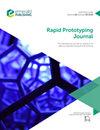汽车悬架减震保险杠的多材料3D打印
IF 3.6
4区 工程技术
Q1 ENGINEERING, MECHANICAL
引用次数: 0
摘要
本研究的目的是评估一种多材料、完全自支撑的辅助结构的3D可打印性。这将有助于扩大增材制造(AM)在汽车悬架等新产品中的应用。设计/方法/方法在多挤出机3D打印机上进行了样品制作的实验方法,并通过压缩测试进行了表征,同时进行了数值模拟,用于支持缓冲缓冲器不同辅助配置的设计。结果表明,单件打印结构的性能优于多个单模块堆叠结构。研究限制/启示3D打印过程的质量影响最终组件的性能和结果的可重复性。因此,鼓励研究人员进一步研究元件制造优化,以实现更可靠的工艺。这项研究工作可以帮助改善汽车悬架系统的关键部件的制造和功能,例如缓冲器,它可以通过吸收冲击能量来有效地降低噪音、振动和粗糙度。在以前的研究中,已经提出了用于减震缓冲器的减震结构。然而,据作者所知,在这项工作中,AM方法首次用于制造多材料的消声结构,不仅通过与刚性聚合物共打印柔性热塑性聚合物,而且还通过连续挤出消声细胞模块的多层结构。本文章由计算机程序翻译,如有差异,请以英文原文为准。
Multimaterial 3D printing of auxetic jounce bumpers for automotive suspensions
Purpose The purpose of this study is to evaluate the 3D printability of a multimaterial, fully self-supporting auxetic structure. This will contribute to expanding the application of additive manufacturing (AM) to new products, such as automotive suspensions. Design/methodology/approach An experimental approach for sample fabrication on a multiextruder 3D printer and characterization by compression testing was conducted along with numerical simulations, which were used to support the design of different auxetic configurations for the jounce bumper. Findings The effect of stacking different auxetic cell modules was discussed, and the findings demonstrated that a one-piece printed structure has a better performance than one composed of multiple single modules stacked on top of each other. Research limitations/implications The quality of the 3D printing process affected the performance of the final components and reproducibility of the results. Therefore, researchers are encouraged to further study component fabrication optimization to achieve a more reliable process. Practical implications This research work can help improve the manufacturing and functionality of a critical element of automotive suspension systems, such as the jounce bumper, which can efficiently reduce noise, vibration and harshness by absorbing impact energy. Originality/value In previous research, auxetic structures for the application of jounce bumpers have already been suggested. However, to the best of the authors’ knowledge, in this work, an AM approach was used for the first time to fabricate multimaterial auxetic structures, not only by co-printing a flexible thermoplastic polymer with a stiffer one but also by continuously extruding multilevel structures of auxetic cell modules.
求助全文
通过发布文献求助,成功后即可免费获取论文全文。
去求助
来源期刊

Rapid Prototyping Journal
工程技术-材料科学:综合
CiteScore
8.30
自引率
10.30%
发文量
137
审稿时长
4.6 months
期刊介绍:
Rapid Prototyping Journal concentrates on development in a manufacturing environment but covers applications in other areas, such as medicine and construction. All papers published in this field are scattered over a wide range of international publications, none of which actually specializes in this particular discipline, this journal is a vital resource for anyone involved in additive manufacturing. It draws together important refereed papers on all aspects of AM from distinguished sources all over the world, to give a truly international perspective on this dynamic and exciting area.
-Benchmarking – certification and qualification in AM-
Mass customisation in AM-
Design for AM-
Materials aspects-
Reviews of processes/applications-
CAD and other software aspects-
Enhancement of existing processes-
Integration with design process-
Management implications-
New AM processes-
Novel applications of AM parts-
AM for tooling-
Medical applications-
Reverse engineering in relation to AM-
Additive & Subtractive hybrid manufacturing-
Industrialisation
 求助内容:
求助内容: 应助结果提醒方式:
应助结果提醒方式:


